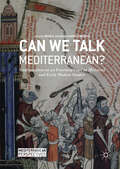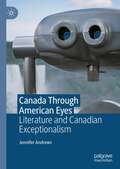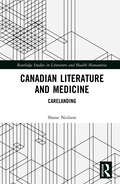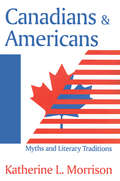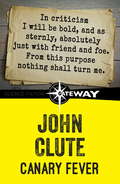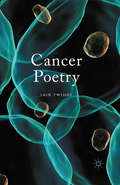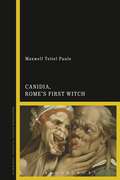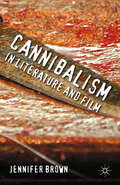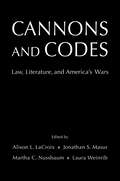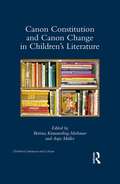- Table View
- List View
Can We Talk Mediterranean?: Conversations on an Emerging Field in Medieval and Early Modern Studies (Mediterranean Perspectives)
by Brian A. Catlos and Sharon KinoshitaThis book provides a systematic framework for the emerging field of Mediterranean studies, collecting essays from scholars of history, literature, religion, and art history that seek a more fluid understanding of “Mediterranean.” It emphasizes the interdependence of Mediterranean regions and the rich interaction (both peaceful and bellicose, at sea and on land) between them. It avoids applying the national, cultural and ethnic categories that developed with the post-Enlightenment domination of northwestern Europe over the academy, working instead towards a dynamic and thoroughly interdisciplinary picture of the Mediterranean. Including an extensive bibliography and a conversation between leading scholars in the field, Can We Talk Mediterranean? lays the groundwork for a new critical and conceptual approach to the region.
Canada Through American Eyes: Literature and Canadian Exceptionalism
by Jennifer AndrewsThis book explores how Canada is imagined primarily by US writers, and what readers and scholars on both sides of the Canada-US border can learn from these recent depictions by examining a selection of US-authored fiction from 9/11 to the present. The novels — and occasionally paintings, films, and musicals — that are the subject of the book provide a deliberately varied set of case studies to probe how US texts, along with works of art produced on both sides of the Canada-US border, uncover moments in Canadian historical and literary studies that have been buried or occluded to protect Canada's self-representation as an exceptional nation.
Canadian English: A Sociolinguistic Perspective
by James A. WalkerThis textbook is the only one of its kind to introduce the study of Canadian English in the context of basic concepts of linguistics and sociolinguistics. The book provides foundational information on linguistic principles and on the different branches of sociolinguistics, ranging from the large-scale ‘macro’ study of language usage (the sociology of language, dialect surveys) to the ‘micro’ study of language use (sociophonetics, sociolinguistic variation and change). Each chapter highlights the different ways of collecting and analyzing data, including census data and historical texts, surveys and questionnaires, publically available corpora, and interviews. Mini-projects at the end of each chapter offer hands-on experience with the methods presented in the chapter. In addition to discussing the classic works in the study of Canadian English, this book engages with such contemporary issues as new-dialect formation, language and social identity, and ongoing language change, making it key reading for students taking courses in the areas of Canadian English, varieties of English, language variation, and sociolinguistics.
Canadian English: A Sociolinguistic Perspective
by James A. WalkerThis textbook is the only one of its kind to introduce the study of Canadian English in the context of basic concepts of linguistics and sociolinguistics. The book provides foundational information on linguistic principles and on the different branches of sociolinguistics, ranging from the large-scale ‘macro’ study of language usage (the sociology of language, dialect surveys) to the ‘micro’ study of language use (sociophonetics, sociolinguistic variation and change). Each chapter highlights the different ways of collecting and analyzing data, including census data and historical texts, surveys and questionnaires, publically available corpora, and interviews. Mini-projects at the end of each chapter offer hands-on experience with the methods presented in the chapter. In addition to discussing the classic works in the study of Canadian English, this book engages with such contemporary issues as new-dialect formation, language and social identity, and ongoing language change, making it key reading for students taking courses in the areas of Canadian English, varieties of English, language variation, and sociolinguistics.
Canadian Historical Writing: Reading the Remains
by R. HulanCanadian Historical Writing presents an archaeology of contemporary Canadian historical writing within the theory and practice of historiography. Drawing on international debates within the fields of literary studies and history, the book focuses on the roles played by time, evidence, and interpretation in defining the historical.
Canadian Literature and Medicine: Carelanding (Routledge Studies in Literature and Health Humanities)
by Shane NeilsonCanadian Literature and Medicine breaks new ground by formulating a series of frameworks with which to read and interpret a national literature derived from the very fabric of that literature – in this case Canadian. Canadian literature is of particular interest because of its consideration of coloniality, Indigeneity, and coincident development alongside a nascent socialized medical system currently under threat from neoliberalism. The first chapters of the book carefully track the development of Canada’s socialized medical system as it manifests in the imaginations of the nation’s poets and authors who depict care. Reciprocal flows are investigated in which these poets and authors are quoted in policy documents. The archive-based methodology is sustained in subsequent chapters that rely upon a unique interdisciplinary mix of medical history, philosophy of medicine, medical policy, theory inherent to the field of Canadian literature (focusing in particular on the garrison mentality as a form of aesthetic protest and the feminist ethics of care), and Indigenous ways of knowing.
Canadian Literature and Medicine: Carelanding (Routledge Studies in Literature and Health Humanities)
by Shane NeilsonCanadian Literature and Medicine breaks new ground by formulating a series of frameworks with which to read and interpret a national literature derived from the very fabric of that literature – in this case Canadian. Canadian literature is of particular interest because of its consideration of coloniality, Indigeneity, and coincident development alongside a nascent socialized medical system currently under threat from neoliberalism. The first chapters of the book carefully track the development of Canada’s socialized medical system as it manifests in the imaginations of the nation’s poets and authors who depict care. Reciprocal flows are investigated in which these poets and authors are quoted in policy documents. The archive-based methodology is sustained in subsequent chapters that rely upon a unique interdisciplinary mix of medical history, philosophy of medicine, medical policy, theory inherent to the field of Canadian literature (focusing in particular on the garrison mentality as a form of aesthetic protest and the feminist ethics of care), and Indigenous ways of knowing.
Canadian Science Fiction, Fantasy, and Horror: Bridging the Solitudes (Studies in Global Science Fiction)
by Amy J. Ransom Dominick GraceCanadian Science Fiction, Fantasy, and Horror: Bridging the Solitudes exposes the limitations of the solitudes concept so often applied uncritically to the Canadian experience. This volume examines Canadian and Québécois literature of the fantastic across its genres—such as science fiction, fantasy, horror, indigenous futurism, and others—and considers how its interrogation of colonialism, nationalism, race, and gender works to bridge multiple solitudes. Utilizing a transnational lens, this volume reveals how the fantastic is ready-made for exploring, in non-literal terms, the complex and problematic nature of intercultural engagement.
Canadians and Americans: Myths and Literary Traditions
by Katherine L. MorrisonMuch can be learned from a nation's literature. Examining three hundred years of cultural traditions, Katherine L. Morrison, a former American, now a Canadian, takes the reader through the historical, political, and sociological milieu of Canada and the United States to dispel misconceptions that they share near-identical social attitudes and historical experiences.To most Americans and much of the rest of the world, America and Canada differ little except in terms of climate. It is true that they share a common British heritage and immigration patterns, but there are subtle cultural differences between the two countries. These may appear insignificant to Americans, but they are not insignificant to Canadians. Comparing mythologies each of the countries share about the other, the author examines national views of their histories, from the common origin of both nations in the American Revolution, through the two world wars. She also examines the role of nature and images of place and home in Canadian and American literary writing, noting the disparate historical development of the two national literatures. Using specific works by recognized authors of their time, Morrison considers the role of religion and the church, violence and the law, and humor and satire, in the literature of both countries. The book also explores the role of women, race, and class in the literature of both countries. It concludes with a discussion of the tenacity of national myths, and draws some tentative conclusions.Now published in paperback in the United States, Morrison's broad-based approach to a largely unexplored subject will invite future study as well as improve understanding between Canada and the United States. Canadians and Americans will be of interest to cultural historians, American studies specialists, political scientists, and sociologists.
Canadians and Americans: Myths and Literary Traditions
by Katherine L. MorrisonMuch can be learned from a nation's literature. Examining three hundred years of cultural traditions, Katherine L. Morrison, a former American, now a Canadian, takes the reader through the historical, political, and sociological milieu of Canada and the United States to dispel misconceptions that they share near-identical social attitudes and historical experiences.To most Americans and much of the rest of the world, America and Canada differ little except in terms of climate. It is true that they share a common British heritage and immigration patterns, but there are subtle cultural differences between the two countries. These may appear insignificant to Americans, but they are not insignificant to Canadians. Comparing mythologies each of the countries share about the other, the author examines national views of their histories, from the common origin of both nations in the American Revolution, through the two world wars. She also examines the role of nature and images of place and home in Canadian and American literary writing, noting the disparate historical development of the two national literatures. Using specific works by recognized authors of their time, Morrison considers the role of religion and the church, violence and the law, and humor and satire, in the literature of both countries. The book also explores the role of women, race, and class in the literature of both countries. It concludes with a discussion of the tenacity of national myths, and draws some tentative conclusions.Now published in paperback in the United States, Morrison's broad-based approach to a largely unexplored subject will invite future study as well as improve understanding between Canada and the United States. Canadians and Americans will be of interest to cultural historians, American studies specialists, political scientists, and sociologists.
Canary Fever
by John CluteCanary Fever is a collection of reviews about the most significant literatures of the twenty-first century: science fiction, fantasy and horror: the literatures Clute argues should be recognized as the central modes of fantastika in our times. The title refers to the canary in the coal mine, who whiffs gas and dies to save miners; reviewers of fantastika can find themselves in a similar position, though words can only hurt us.
Cancelled Words: Rediscovering Thomas Hardy
by Rosemarie MorganThe manuscript of Hardy's first great novel Far From the Madding Crowd vanished shortly after its first publication. Rediscovered in 1918 it sheds remarkable new light on the whole of Hardy's work. The manuscript pages, some of which are reproduced here in facsimile, reveal Hardy's original composition in the novel, and the reluctantly `cancelled words' which were the result of a long struggle with Sir Leslie Stephen, Hardy's editor. Cancelled Words reveals the manner in which Hardy worked, his resistance to censorship, his obsessive attention to detail and precision, and the often concealed processes underlying his authorship. Ultimately, it serves to shape our understanding of the development of the modern novel.
Cancelled Words: Rediscovering Thomas Hardy
by Rosemarie MorganThe manuscript of Hardy's first great novel Far From the Madding Crowd vanished shortly after its first publication. Rediscovered in 1918 it sheds remarkable new light on the whole of Hardy's work. The manuscript pages, some of which are reproduced here in facsimile, reveal Hardy's original composition in the novel, and the reluctantly `cancelled words' which were the result of a long struggle with Sir Leslie Stephen, Hardy's editor. Cancelled Words reveals the manner in which Hardy worked, his resistance to censorship, his obsessive attention to detail and precision, and the often concealed processes underlying his authorship. Ultimately, it serves to shape our understanding of the development of the modern novel.
Cancer Poetry
by Iain TwiddyThis is the first critical study to offer a sustained analysis of the theme of cancer in contemporary poetry. In discussing works by major poets, including Paul Muldoon, Jo Shapcott and Christopher Reid, Cancer Poetry traces the complex ways in which poets represent cancer, and assesses how poetry can be instrumental to emotional recovery.
The Cane (Modern Plays)
by Mark RavenhillIt will be the biggest send off any teacher has ever had. No teacher is as loved. After 45 years as a dedicated teacher, Edward is looking forward to the imminent celebration to mark his retirement.But his home is under siege. A mob of angry students have gathered. A brick has been thrown through the window, he and his wife haven't left the house for six days, and now his estranged daughter has arrived with her own questions.Why would they attack the most popular teacher in the school?The Cane explores power, control, identity and gender as well as considering the major failure of the echo-chamber of liberalism.
The Cane (Modern Plays)
by Mark RavenhillIt will be the biggest send off any teacher has ever had. No teacher is as loved. After 45 years as a dedicated teacher, Edward is looking forward to the imminent celebration to mark his retirement.But his home is under siege. A mob of angry students have gathered. A brick has been thrown through the window, he and his wife haven't left the house for six days, and now his estranged daughter has arrived with her own questions.Why would they attack the most popular teacher in the school?The Cane explores power, control, identity and gender as well as considering the major failure of the echo-chamber of liberalism.
Canidia, Rome’s First Witch
by Maxwell Teitel PauleCanidia is one of the most well-attested witches in Latin literature. She appears in no fewer than six of Horace's poems, three of which she has a prominent role in. Throughout Horace's Epodes and Satires she perpetrates acts of grave desecration, kidnapping, murder, magical torture and poisoning. She invades the gardens of Horace's literary patron Maecenas, rips apart a lamb with her teeth, starves a Roman child to death, and threatens to unnaturally prolong Horace's life to keep him in a state of perpetual torment. She can be seen as an anti-muse: Horace repeatedly sets her in opposition to his literary patron, casts her as the personification of his iambic poetry, and gives her the surprising honor of concluding not only his Epodes but also his second book of Satires. This volume is the first comprehensive treatment of Canidia. It offers translations of each of the three poems which feature Canidia as a main character as well as the relevant portions from the other three poems in which Canidia plays a minor role. These translations are accompanied by extensive analysis of Canidia's part in each piece that takes into account not only the poems' literary contexts but their magico-religious details.
Canidia, Rome’s First Witch
by Maxwell Teitel PauleCanidia is one of the most well-attested witches in Latin literature. She appears in no fewer than six of Horace's poems, three of which she has a prominent role in. Throughout Horace's Epodes and Satires she perpetrates acts of grave desecration, kidnapping, murder, magical torture and poisoning. She invades the gardens of Horace's literary patron Maecenas, rips apart a lamb with her teeth, starves a Roman child to death, and threatens to unnaturally prolong Horace's life to keep him in a state of perpetual torment. She can be seen as an anti-muse: Horace repeatedly sets her in opposition to his literary patron, casts her as the personification of his iambic poetry, and gives her the surprising honor of concluding not only his Epodes but also his second book of Satires. This volume is the first comprehensive treatment of Canidia. It offers translations of each of the three poems which feature Canidia as a main character as well as the relevant portions from the other three poems in which Canidia plays a minor role. These translations are accompanied by extensive analysis of Canidia's part in each piece that takes into account not only the poems' literary contexts but their magico-religious details.
Canines in Cervantes and Velázquez: An Animal Studies Reading of Early Modern Spain
by John BeusterienThe study of the creation of canine breeds in early modern Europe, especially Spain, illustrates the different constructs against which notions of human identity were forged. This book is the first comprehensive history of early modern Spanish dogs and it evaluates how two of Spain’s most celebrated and canonical cultural figures of this period, the artist Diego Velázquez and the author Miguel de Cervantes, radically question humankind’s sixteenth-century anthropocentric self-fashioning. In general, this study illuminates how Animal Studies can offer new perspectives to understanding Hispanism, giving readers a fresh approach to the historical, literary and artistic complexity of early modern Spain.
Canines in Cervantes and Velázquez: An Animal Studies Reading of Early Modern Spain
by John BeusterienThe study of the creation of canine breeds in early modern Europe, especially Spain, illustrates the different constructs against which notions of human identity were forged. This book is the first comprehensive history of early modern Spanish dogs and it evaluates how two of Spain’s most celebrated and canonical cultural figures of this period, the artist Diego Velázquez and the author Miguel de Cervantes, radically question humankind’s sixteenth-century anthropocentric self-fashioning. In general, this study illuminates how Animal Studies can offer new perspectives to understanding Hispanism, giving readers a fresh approach to the historical, literary and artistic complexity of early modern Spain.
Cannibalism in High Medieval English Literature (The New Middle Ages)
by H. BlurtonThis book reads the surprisingly widespread representations of cannibals and cannibalism in medieval English literature as political metaphors that were central to England's on-going process of articulating cultural and national identity.
Cannibalism in Literature and Film
by J. BrownA comprehensive study of cannibalism in literature and film, spanning colonial fiction, Gothic texts and contemporary American horror. Amidst the sharp teeth and horrific appetite of the cannibal, this book examines real fears of over-consumerism and consumption that trouble an ever-growing modern world.
Cannons and Codes: Law, Literature, and America's Wars
by Alison L. Lacroix, Jonathan S. Masur, Martha C. Nussbaum, Laura WeinribIt can be said that western literature begins with a war story, the Iliad; and that this is true too of many non-Western literary traditions, such as the Mahabharata. And yet, though a profoundly human subject, war often appears to be by definition outside the realm of structures such as law and literature. When we speak of war, we often understand it as incapable of being rendered into rules or words. Lawyers struggle to fit the horrors of the battlefield, the torture chamber, or the makeshift hospital filled with wounded and dying civilians into the framework of legible rules and shared understandings that law assumes and demands. In the West's centuries-long effort to construct a formal law of war, the imperative has been to acknowledge the inhumanity of war while resisting the conclusion that it need therefore be without law. Writers, in contrast, seek to find the human within war--an individual story, perhaps even a moment of comprehension. Law and literature might in this way be said to share imperialist tendencies where war is concerned: toward extending their dominion to contain what might be uncontainable. Law, literature, and war are thus all profoundly connected--and it is this connection this edited volume aims to explore, assembling essays by preeminent scholars to discuss the ways in which literary works can shed light on legal thinking about war, and how a deep understanding of law can lead to interpretive insights on literary works. Some of the contributions concern the lives of soldiers; others focus on civilians living in war zones who are caught up in the conflict; still others address themselves to the home front, far from the theatre of war. By collecting such diverse perspectives, the volume aims to illuminate how literature has reflected the totalizing nature of war and the ways in which it distorts law across domains.
Cannons and Codes: Law, Literature, and America's Wars
It can be said that western literature begins with a war story, the Iliad; and that this is true too of many non-Western literary traditions, such as the Mahabharata. And yet, though a profoundly human subject, war often appears to be by definition outside the realm of structures such as law and literature. When we speak of war, we often understand it as incapable of being rendered into rules or words. Lawyers struggle to fit the horrors of the battlefield, the torture chamber, or the makeshift hospital filled with wounded and dying civilians into the framework of legible rules and shared understandings that law assumes and demands. In the West's centuries-long effort to construct a formal law of war, the imperative has been to acknowledge the inhumanity of war while resisting the conclusion that it need therefore be without law. Writers, in contrast, seek to find the human within war--an individual story, perhaps even a moment of comprehension. Law and literature might in this way be said to share imperialist tendencies where war is concerned: toward extending their dominion to contain what might be uncontainable. Law, literature, and war are thus all profoundly connected--and it is this connection this edited volume aims to explore, assembling essays by preeminent scholars to discuss the ways in which literary works can shed light on legal thinking about war, and how a deep understanding of law can lead to interpretive insights on literary works. Some of the contributions concern the lives of soldiers; others focus on civilians living in war zones who are caught up in the conflict; still others address themselves to the home front, far from the theatre of war. By collecting such diverse perspectives, the volume aims to illuminate how literature has reflected the totalizing nature of war and the ways in which it distorts law across domains.
Canon Constitution and Canon Change in Children's Literature (Children's Literature and Culture)
by Bettina Kümmerling-Meibauer Anja MüllerThis volume focuses on the (de)canonization processes in children’s literature, considering the construction and cultural-historical changes of canons in different children’s literatures. Chapters by international experts in the field explore a wide range of different children’s literatures from Great Britain, Germany, Scandinavia, the Low Countries, Eastern and Central Europe, as well as from Non-European countries such as Australia, Israel, and the United States. Situating the inquiry within larger literary and cultural studies conversations about canonicity, the contributors assess representative authors and works that have encountered changing fates in the course of canon history. Particular emphasis is given to sociological canon theories, which have so far been under-represented in canon research in children’s literature. The volume therefore relates historical changes in the canon of children’s literature not only to historical changes in concepts of childhood but to more encompassing political, social, economic, cultural, and ideological shifts. This volume’s comparative approach takes cognizance of the fact that, if canon formation is an important cultural factor in nation-building processes, a comparative study is essential to assessing transnational processes in canon formation. This book thus renders evident the structural similarities between patterns and strategies of canon formation emerging in different children’s literatures.
